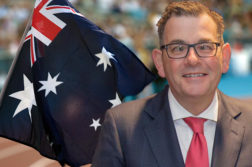Princess Margaret Hospital, currently WA’s major paediatric hospital, is scheduled to be closed in 2015 and replaced by Perth Children’s Hospital, a new $1.2 billion facility near Perth’s CBD. It should have been an easy sell for Premier Colin Barnett's government, but the designs have been plagued with criticism since their release.
Parents' groups and the Australian Medical Association both say the new hospital will not have enough extra capacity to replace the Princess Margaret Hospital (PMH), which opened in 1909 and is unable to meet current demand. They predict more horror stories for sick kids unless the number of new beds is significantly increased.
The new hospital planned by Barnett's government was initially going to include just 24 more beds — a number that was changed to 48 after community pressure. This wasn’t enough to appease parents, who are campaigning to add an extra storey to the new hospital.
Barnett and his Deputy Premier and Minister for Health Kim Hames insist that by reconfiguring the initial plans instead of building an extra floor they will save the state $70 million. Paediatric services will still be able to meet demand until 2021, they say. They also argue that the design of the hospital will allow future governments to add extra floors to the building.
But the President of the Australian Medical Association in WA, Dr Richard Choong, has cast doubt on these estimates, claiming that unreleased internal Department of Health documents show the new hospital will meet its capacity by 2017. According to Dr Choong, the extra 48 beds are nowhere near enough, because the government relies on outdated modelling which had failed to anticipate the state’s rapid population growth.
“We’ve asked for an extra 100 beds or two floors. We haven’t got either. They’ve assured us that in the future a government can put up to four floors on the hospital. However, that is not really future-proofing the hospital. What we need is to have a hospital that has the capacity to meet the growing demand and the growing population size well into the future,” Choong told New Matilda.
The demand placed on government services in WA is growing with its population, which has spiked by 330,000 since 2008 due to the mining boom. Health services are already under significant pressure from an increase in the permanent population, and the influx of 'fly in, fly out' workers.
The breakdown in paediatric services puts lives at risk. In 2011, Christine Brown’s 13-year-old daughter Caitlyn told her mother she felt suicidal. Caitlyn was suffering from post traumatic stress disorder and experiencing significant anxiety and depression. Afraid, Christine drove Caitlyn to PMH.
On arrival, Christine and Caitlyn waited until 5am before being able to speak to a psychiatrist. Advised that an extended stay would not be necessary and in-house visits adequate, the pair returned home.
“Their policy is to have a very short stay and do the majority of the mental health care out in home or out in the community,” Brown told NM. “What we’ve found is the Princess Margaret strategy of getting the kids in quickly and having short term stays isn’t always the best choice for the kids when they’re in crisis.”
Five days after being discharged, Caitlyn took an overdose of panadol and antidepressants in an attempt to commit suicide. She was rushed back to PMH.
Debra Butler’s five children are regulars at PMH because three of her sons suffer from haemophilia. But it was her daughter’s bowel condition that brought the hospital’s undersupply of beds to her attention.
After multiple misdiagnoses her daughter Georgia was eventually confirmed to be suffering from a bowel blockage but, because of the lack of bedspace, was forced to stay in the hospital’s burns ward. Like all of the parents NM approached, Butler noted that the hospital’s staff had done everything they could for her children.
“The staff at Princess Margaret are fantastic, I’ve never come across a nurse or a doctor who have been anything but amazing. But the lack of beds just means that the right staff don’t look after the right children with the right illnesses. I mean a blocked bowel was being looked after by a burns nurse,” she said.
“It wasn’t the right area for Georgia to be in. She should have been on a general ward but they just didn’t have enough beds."
Another parent, Rachel Curtis, twice experienced problems because of PMH’s insufficient number of beds. On both occasions she was forced to move between private and public hospitals, and in one instance had to wait four hours while the various institutions negotiated who would take her sick, newborn daughter.
“The stress doesn’t just extend out to myself, my husband, and daughters. It extends out to the extended family because they have to pick up all the pieces and do all the driving and running around because we didn’t have a bed,” she said.
Like the other parents, Curtis is sceptical about the government’s promises: “I’m not confident at all and that’s because of the experiences I’ve had.”
Greens MLC Lynn MacLaren is also unconvinced by the government’s assurances. “Perth Children’s Hospital is going to be over-stretched as soon as it opens, for a project that has cost the Government $1.2 billion, that is a saddening thought for all involved,” she told NM by email.
The West Australian government has responded to the growing outcry by arguing it is too late to make changes to the current construction plans. Opposition leader Mark McGowan has rejected the claim and called for the state’s regional royalties funds to provide the extra finances.
A Facebook group for parents to organise petitions and protest actions has over 6500 members. One person recently posted to the group from PMH’s notorious 3B cancer ward, where they said they were waiting for their son to get a bed. Another post from Labor MLA Roger Cook said that a petition with 1000 signatures calling for an increase to the number of mental health beds had been presented to the Minister for Health.
At the time of publication the Perth Children’s Hospital Project, which is overseeing the transition, was yet to respond to NM's questions or confirm whether they were aware of the above cases. The Premier’s office was also yet to respond.
Though thankful to Western Australia’s Child and Adolescent Health Services for putting her daughter on the road to recovery, Christine Brown is worried the new hospital will not overcome the problems her family encountered at the PMH.
“I would be willing to put it out there that I believe we will lose young people [because of]the decision they are making. It was Princess Margaret that saved my daughter’s life when she had an overdose … but if we hadn’t got there in time we would have lost her [because she was]turned away due to [PMH] not having enough beds … and I think that’s going to continue to happen.”
Donate To New Matilda
New Matilda is a small, independent media outlet. We survive through reader contributions, and never losing a lawsuit. If you got something from this article, giving something back helps us to continue speaking truth to power. Every little bit counts.



